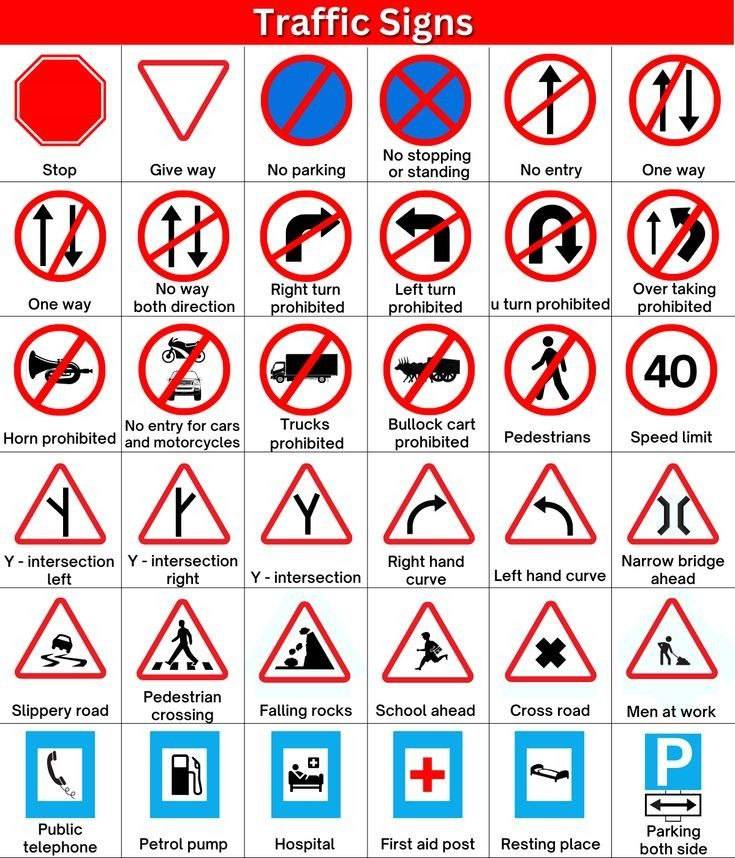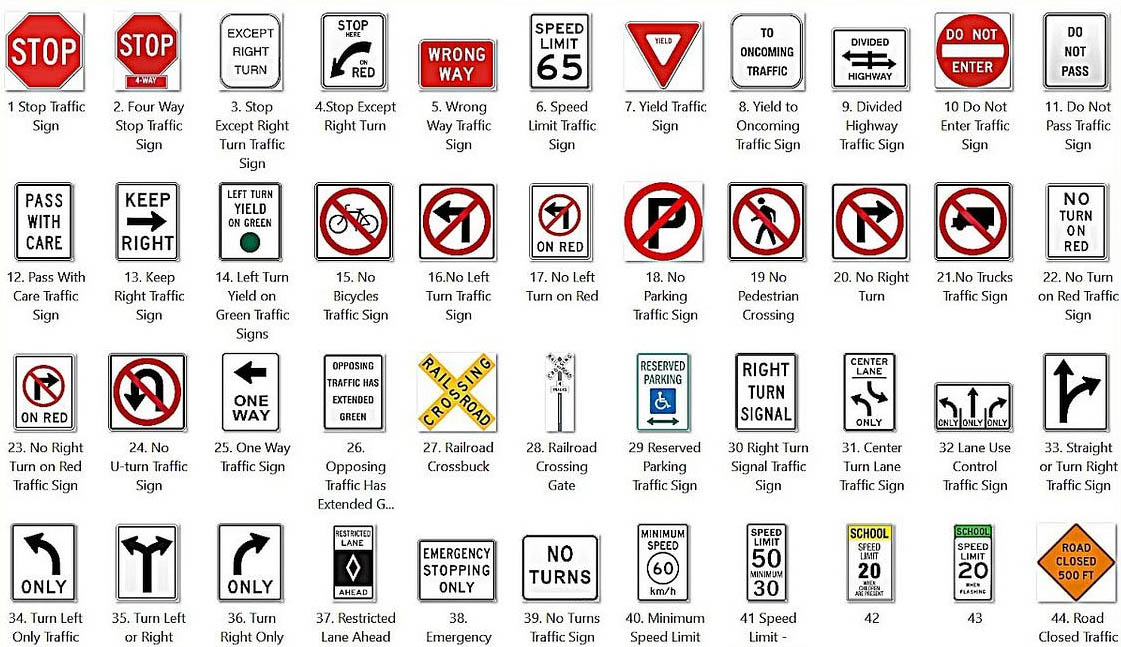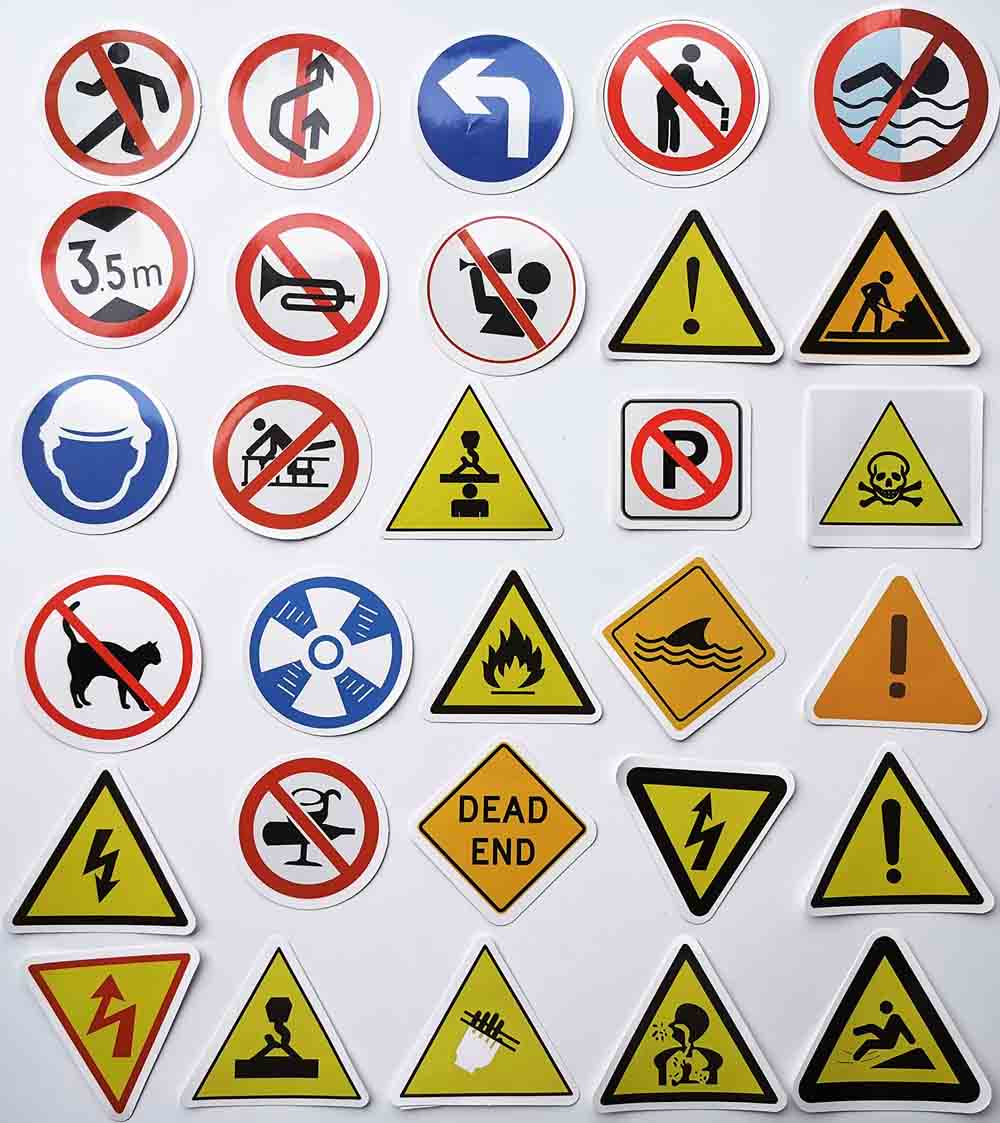Дорожные знаки Они не новы, поскольку предприятия уже давно устанавливают их на дорогах для обеспечения безопасности водителей и информирования водителей. Но мало кто до сих пор понимает значение этих дорожных знаков. Именно поэтому мы подготовили для вас это руководство, в котором собрано всё, что необходимо знать о дорожных знаках каждому предприятию и гражданину.
Что такое дорожный знак?
Дорожный знак (часто называемый дорожным знаком) — это небольшая цветная табличка, размещаемая над дорогами или вдоль них. Они используются для передачи важной информации о потенциальных опасностях, текущей ситуации впереди, зонах с ограниченным движением или для предоставления инструкций водителям, пешеходам и другим участникам дорожного движения. Знаки бывают разных цветов, размеров, форм, графики и инструкций для различных целей.
Что означает дорожный знак?
Значение дорожного знака, или, скажем так, его цель, заключается в том, чтобы просто донести определённую информацию до всех участников дорожного движения и обеспечить их безопасность. Поэтому, когда вы видите дорожный знак на дороге, знайте, что он служит для того, чтобы направлять, предупреждать или предупредить вас о том, что вас ждёт на пути.
Рассмотрим пример: вы едете по дороге на большой скорости и видите чёрно-жёлтый ромбовидный знак «Снижение скорости». Когда вы подъезжаете к этому знаку, вам следует снизить скорость, поскольку существует вероятность, что впереди ведутся строительные или ремонтные работы. Однако, если вы проигнорируете знак и продолжите движение на высокой скорости, вы можете подвергнуть опасности себя и окружающих.
И та же логика применима к любому другому дорожному знаку. Каждый из них несёт для вас послание. Всё, что вам нужно сделать, — это просто прочитать, понять и вовремя отреагировать.
Почему дорожные знаки важны (особенно для бизнеса)?
Дорожные знаки предназначены не только для общественности. Они также важны для бизнеса. Ниже мы объясним, как эти дорожные знаки могут принести пользу вашему бизнесу:
- Они направляют ваших клиентов – Предположим, у вас есть торговый комплекс, и новый водитель или клиент не может найти ваш магазин. Он может расстроиться или в итоге отправиться в другой торговый комплекс. Но если вы разместите правильные указатели (вместе с названием вашей компании), ваши клиенты легко доберутся до вашего магазина.
- Они обеспечивают безопасность всех. – На дорожных работах или строительных площадках часто бывают водители доставки, сотрудники или посетители. В таких случаях вы можете разместить соответствующие знаки, например, «Впереди строительные работы» или «Работают мужчины» перед стройплощадкой. Таким образом, вы сможете направлять водителей и предупредить их о необходимости соблюдать осторожность. Кроме того, вы обеспечите безопасность своих сотрудников и снизите риск аварий на стройплощадке.
- Они создают профессиональный имидж – В вашем офисе или на рабочем месте вы можете разместить соответствующие таблички вдоль дорог для клиентов и сотрудников. Например, «Главный офис», «Доставка в этом направлении» или «Ограничение скорости 10 км/ч». Этот простой приём создаст ваш профессиональный имидж в глазах клиентов и покажет, что вы заботитесь о деталях.
- Они позволяют вам соблюдать правила и избегать штрафов – Во многих отраслях, особенно в строительстве и логистике, предупреждающие знаки обязательны по закону, например, «Высокое напряжение» или «Вход воспрещён. Только для авторизованного персонала». Поэтому, правильно разместив предупреждающие и направляющие знаки на рабочем месте, будь то на дороге или внутри здания, вы будете соблюдать местные правила и избегать крупных штрафов и наказаний.
- Они расширяют возможности вашего бренда и маркетинга – Вы даже можете использовать индивидуальные дорожные знаки и размещать их на дорогах. В JACKWIN мы изготавливаем персонализированные дорожные знаки с логотипом, цветами и надписью вашего бренда. Это поможет вам привлечь больше клиентов и даже расширить свой бренд.
Различные типы дорожных знаков

-
Регулирующие знаки
Предписывающие знаки, как правило, сообщают о правилах дорожного движения. Именно поэтому они обязательны для всех. Они, как правило, красного, жёлтого и чёрного цветов. Игнорирование их подвергает кого-либо опасности или рискует получить штраф. Ниже мы собрали список распространённых регулирующих знаков:
Знак «Стоп»: Они красного цвета и имеют форму восьмиугольника. Доехав до этого знака, необходимо остановиться, посмотреть в обе стороны и продолжить движение.
Знак «Уступите дорогу»: Обычно красного и белого цветов, треугольной формы. Он призывает вас снизить скорость и уступить дорогу другим транспортным средствам. Если никто не едет, вы можете продолжать движение с небольшой скоростью.
Не входить: Это просто означает, что въезд запрещён. Если вы въедете, вы подвергнете себя опасности, поскольку такие знаки обычно используются в зонах с ограниченным движением или на участках с постоянным встречным движением.
Разворот запрещен / поворот налево запрещен / поворот направо запрещен: Эти знаки указывают на определённые направления. Например, «Разворот запрещён». Это означает, что разворот запрещён.
Знак ограничения скорости: Самый распространённый знак, на котором обычно указана разрешённая скорость. Поэтому, увидев такой знак, обязательно двигайтесь с разрешённой скоростью, иначе вас оштрафуют.
Парковка/остановка запрещены: Проще говоря, вам не разрешается останавливаться или парковать свое транспортное средство.
В одну сторону: Он сообщает вам, что эта дорога имеет одностороннее движение, поэтому вы тоже едете в том же направлении.
Обгон запрещен / сигнал запрещен: Чаще всего эти знаки можно увидеть в тихих зонах, на территориях больниц или на узких дорогах. Они сообщают, что обгон и ненужные сигналы запрещены.

-
Предупреждающие знаки
Предупреждающие знакиС другой стороны, они предупреждают о любой потенциальной опасности впереди. Обычно они жёлтого/оранжевого цвета с чёрными символами или текстом. Чаще всего используются в зонах, где предупреждение водителям критически важно. Например, в школьных зонах, на строительных площадках и т. д. Теперь давайте обсудим распространённые предупреждающие знаки и их значение:
Впереди поворот / крутой поворот: Этот знак предупреждает о приближающемся повороте (влево или вправо). Поэтому вам следует снизить скорость и ехать осторожно.
Скользкая дорога: Чаще всего их можно увидеть в дождливую или туманную погоду. Они просто предупреждают о возможной скользкости на дороге. Поэтому следует ехать медленнее и избегать резких торможений.
Пешеходный переход: Увидев этот знак, обязательно остановитесь и обратите внимание на пешеходов. Как только они перейдут дорогу, вы сможете продолжить движение. Этот знак можно увидеть возле школ, офисов и оживлённых рынков.
Пересечение животных: Вы увидите их вблизи любых сельских, лесных участков или мест, где часто встречаются животные. Этот знак предупреждает о том, что животные могут внезапно пересечь дорогу. Поэтому двигайтесь медленно и будьте внимательны к животным.
Предстоящие строительные работы: Чаще всего устанавливается вблизи строительных площадок или вокруг них. Просто сообщает о текущих дорожных работах или ремонте. Поэтому приходится ехать медленно и осторожно. Поскольку на таких участках полосы движения часто перекрыты, а покрытие неровное.
Впереди светофор: Этот знак просто предупреждает вас о приближении к светофору. Будьте готовы остановиться (при необходимости).
Железнодорожный переезд: Этот знак вы увидите за 500 футов до переезда. Он предупреждает о наличии железнодорожных путей. Поэтому двигайтесь медленно, а когда подъедете к железнодорожному переезду, остановитесь и посмотрите, нет ли поезда. Если переезд свободен, можете продолжать движение.

-
Указатели направления
Эти знаки обычно указывают направления, номера маршрутов, расстояние до ближайших объектов, заправок и экстренных служб. Они обычно зелёного, синего и коричневого цветов с белым текстом или указателями направления. Ниже приведён список распространённых указателей, которые чаще всего встречаются на дорогах:
Знак выхода: В основном размещаются на автомагистралях, скоростных магистралях и автомагистралях. Они подсказывают вам ближайшие съезды и иногда содержат информацию о близлежащих городах или объектах инфраструктуры.
Знак с названием улицы: Чаще всего их можно увидеть в жилых районах. На них указано название улицы и номер дома. Так что ориентироваться будет проще.
Маркеры маршрута: Обычно используются на автомагистралях и шоссе. Они показывают номер маршрута или название шоссе, чтобы вы знали, что едете по правильному пути.
Знаки обслуживания: Их часто можно увидеть на автомагистралях или пунктах взимания платы. Они сообщают о ближайших заправках, больницах, точках питания, зонах отдыха и т. д.
Знаки аэропорта/железнодорожного вокзала/автобусного терминала: На них обычно имеется направленная графика и сообщение. Это указывает на транспортные узлы. Так что вы легко доберётесь до терминалов.
Туристические информационные знаки: Эти знаки обычно сообщают о расположенных поблизости туристических местах, таких как парки, музеи, исторические места или смотровые площадки.
-
Информационные знаки
Что ж, если говорить об информационных дорожных знаках, то они не направляют, не предупреждают и не предупреждают. Вместо этого компании устанавливают их, чтобы донести полезную информацию до клиентов или общественности. Обычно они синие и белые. Давайте теперь рассмотрим наиболее распространённые информационные дорожные знаки:
Знак парковки (П): Сообщает вам, где парковка разрешена, ограничена или запрещена.
Знаки общественного туалета/душевой комнаты: Их можно увидеть в местах массового скопления туристов или в местах массового скопления покупателей, например, в торговых центрах, на рынках или автозаправках. Они показывают наличие туалетов.
Телефон экстренной связи или первой помощи: Эти знаки подскажут вам, где можно получить помощь в случае аварий или поломки.
Впереди заправка: Просто сообщает вам, что приближается бензоколонка.
Правила MUTCD для дорожных знаков
MUTCD регламенты представляют собой свод правил, которые указывают предприятиям, как, какие и где следует использовать и размещать дорожные знаки. Соблюдение этих правил обязательно для каждого учреждения, иначе вас ждут высокие штрафы и наказания. Вот что гласят эти правила:
- Объекты должны обеспечить использование дорожных знаков стандартных форм, цветов и шрифтов, указанных в MUTCD.
- Используйте дорожные знаки со светоотражающей пленкой для улучшения видимости в ночное время.
- Объекты также должны обеспечить размещение дорожных знаков на дорогах или вдоль них. Это позволит водителям и пешеходам легко видеть их даже с большого расстояния. Кроме того, дорожные знаки следует размещать вдали от деревьев и других препятствий.
- Все регулирующие знаки должны размещаться на высоте не менее 7 футов от земли, особенно в городских районах.
- Если дорожные знаки не используются, предприятия должны обеспечить их немедленный демонтаж.
- Дорожные знаки Они должны быть надежно закреплены. Чтобы выдерживать суровые погодные условия.
Стандартные цвета и формы дорожных знаков
На рынке дорожные знаки представлены в разных цветах и формах. Однако MUTCD и OSHA Строго предписывайте использование дорожных знаков на дорогах общего пользования, соответствующих установленным цветовым и формовым требованиям. В таблице ниже указано, какие цвета дорожных знаков используются для каких целей:
| Цвет | Значение | Приложения |
| Красный | Остановка, запрет или опасность | Знаки «Стоп», «Уступите дорогу», «Въезд запрещен», «Неправильный путь» |
| Желтый | Общее предупреждение | Впереди поворот, пешеходный переход, скользкая дорога |
| Зеленый | Направленное наведение | Знаки съезда, указатели расстояния, направления движения по автомагистралям |
| Синий | Услуги/информация для автомобилистов | Зоны отдыха, больницы, газ, жилье |
| Коричневый | Рекреационный и культурный интерес | Парки, музеи, живописные маршруты |
| Белый | Нормативные (законы) | Ограничения скорости, запрет на парковку, ограничения поворота |
| Апельсин | Временные и строительные зоны | Дорожные работы, объезды, впереди рабочие |
| Фиолетовый | Платная дорога или контролируемые полосы | Скоростные полосы, пункты взимания платы (редко) |
| Желто-зеленый | Школьные зоны, пешеходы и велосипеды | Школьные переходы, велосипедные дорожки |
Помимо цветовой кодировки, Руководство по унифицированным устройствам управления дорожным движением (MUTCD) также устанавливает строгие стандарты формы дорожных знаков в США. Их цель — обеспечить единообразие и узнаваемость для водителей. В таблице ниже приведены описания форм дорожных знаков:
| Форма | Предназначено для | Распространенные применения |
| Восьмиугольник (8 сторон) | Стоп (используется только для знаков СТОП) | знаки «Стоп» |
| Треугольник (вершиной вниз) | Уступите дорогу (используется только для знаков YIELD) | Знаки «Уступи дорогу» |
| Алмаз | Предупреждающие знаки (потенциальная опасность) | Впереди поворот, олени переходят дорогу, слияние потоков |
| Прямоугольник (вертикальный) | Нормативные знаки (законы/правила) | Ограничение скорости, парковка запрещена, держитесь правее |
| Прямоугольник (горизонтальный) | Указатели направления | Названия улиц, съезды с автомагистралей и указатели расстояний |
| Пентагон | Зона школы (только для знаков, связанных со школой) | Школьный переход, школьные ограничения скорости |
| Круг | Знаки железнодорожного переезда | Предварительное предупреждение о железной дороге (перекресток) |
| Вымпел (равнобедренный треугольник) | Знаки «Зона, запрещенная для проезда» | Используется на левой стороне дороги, где обгон запрещен. |
Как лучше всего изучать дорожные знаки? – 4 метода
Что ж, если вы спросите нас, как выучить дорожные знаки, мы ответим: учиться, изучать и применять на практике. Ниже мы поделимся четырьмя методами, которые вы можете адаптировать для запоминания дорожных знаков:
Метод 1: Разделите все дорожные знаки на типы: предписывающие, предупреждающие, направляющие и информационные (как мы делали ранее в руководстве). Затем разберитесь и запомните, какая форма или цвет соответствует тому или иному назначению. Например, круглый дорожный знак обозначает железнодорожный переезд, а перевёрнутый треугольник — знак «уступите дорогу».
Метод 2: В интернете доступно множество мобильных приложений и онлайн-игр, специально разработанных для изучения дорожных знаков. Вы можете установить их и попробовать попрактиковаться. В этих приложениях также есть тесты, цифровые карточки и упражнения на сопоставление колонок. Это поможет вам распознать свои ошибки и быстро учиться.
Метод 3: Используйте мнемонику для изучения и запоминания дорожных знаков. Это идеально подходит для тех, кто лучше запоминает информацию. Например, чтобы запомнить круг, представьте его как цикл движения. Так вы сразу вспомните, что круглые знаки обозначают железнодорожные переезды. Для перевёрнутого треугольника представьте его как половину буквы Y. Таким образом, вы сразу вспомните, что Y означает «уступите дорогу».
Метод 4: Вы знаете, что настоящее обучение происходит, когда вы практикуетесь в реальном времени. Поэтому каждый раз, когда вы в дороге, начните обращать внимание на дорожные знаки вокруг вас. Это поможет вам связать знак с его реальным назначением и местом установки. Так эта связь лучше закрепится в вашей памяти, и вы быстро выучите все дорожные знаки.
Пять лучших мест для установки дорожных знаков
На перекрестках и примыканиях:
Знаете, на перекрёстках и развязках встречаются и пересекаются 3-4 дороги. И в случае аварии ущерб будет огромным. Именно поэтому это самая критическая зона, где правильное управление дорожным движением имеет решающее значение. С помощью предупреждающих и регулирующих дорожных знаков вы можете подсказать водителям остановиться и посмотреть по сторонам на светофоры и другие транспортные средства.
На строительных площадках:
Если на дороге ведутся строительные или ремонтные работы, можно установить дорожные знаки, особенно такие, как «Впереди дорожные работы», «Ограничение скорости» или «Впереди объезд». Таким образом, вы сможете предупредить водителей о потенциальной опасности, предупредить их о необходимости быть осторожными и обеспечить безопасность своих сотрудников и рабочих.
На пешеходном переходе:
Через пешеходные переходы проходят люди разных возрастов и с ограниченными возможностями. Поэтому крайне важно установить на дороге дорожный знак «Пешеходный переход». Чтобы каждый водитель, подъезжая к знаку, оглядывался на пешеходов, пропускал их и только после этого мог продолжить движение.
Рядом со школой и детскими площадками:
Как и на пешеходных переходах, на территориях школ и детских площадок также много пешеходов, включая детей и сотрудников, пересекающих дорогу. В таких зонах можно установить дорожные знаки, например, «Школьная зона впереди», «Ограничение скорости» и «Пешеходный переход». Таким образом, вы предупредите водителей о необходимости быть осторожными и двигаться медленно в этих зонах.
На автомагистралях и скоростных магистралях:
С помощью дорожных знаков вы можете направлять, информировать и предупреждать водителей на автомагистралях и скоростных магистралях о любых перестроениях, съездах, объездах, предупреждениях или любой другой ситуации впереди. Здесь вы можете использовать такие дорожные знаки, как знаки ограничения скорости, съезда, обозначения съезда с полосы движения, обозначения зоны строительства впереди и т. д.
Что можно и чего нельзя делать при установке дорожных знаков
Дос:
- Перед установкой дорожных знаков на дорогах общего пользования необходимо всегда консультироваться с местными органами власти или правилами безопасности дорожного движения и убедиться, что дорожные знаки соответствуют стандартам.
- Устанавливайте знаки на уровне глаз, в местах, где нет препятствий и препятствий. Так, чтобы водители и пешеходы могли их легко видеть.
- Придерживайтесь MUTCD (Руководства по унифицированным устройствам управления дорожным движением) и предписанных им дизайнов, цветов и форм знаков.
- Мы рекомендуем устанавливать дорожные знаки перед началом любых работ на дорогах, таких как перекрытие полос движения, ремонт или строительство. Так у водителей будет достаточно времени, чтобы среагировать и понять ситуацию.
- Регулярно очищайте и осматривайте знаки на предмет повреждений, поломок, выцветания или трещин, особенно после штормов или аварий. Если вы обнаружите какие-либо повреждения, немедленно замените их.
Что нельзя делать:
- Большинство предприятий совершают ошибку, перегружая территорию. Поэтому мы рекомендуем не размещать слишком много знаков в одном месте. Это может запутать водителей и привести к несоблюдению ими требований знаков.
- Не размещайте знаки за деревьями и зданиями или вдоль них, так как это может загораживать дорожные знаки, и водители не смогут их видеть.
- Для каждой дороги нужны свои дорожные знаки. Предположим, что на жилых улицах часто требуются уличные знаки, а на дорогах — знаки остановки, пешеходного перехода и другие. Поэтому сначала необходимо проанализировать состояние дороги, а затем соответствующим образом разместить дорожные знаки.
- Не устанавливайте знаки без учёта транспортного потока. Сначала проанализируйте текущую ситуацию на дорогах и поведение водителей, а затем разместите знаки, особенно вблизи перекрёстков.
Подвести итоги
Подводя итог, отметим, что понимание значения и типов каждого дорожного знака крайне важно для соблюдения правил дорожного движения. Если вы владелец бизнеса, специалист по безопасности или дорожно-строительная компания и ищете прочные дорожные знаки, ознакомьтесь с нашим каталогом или свяжитесь с нами сегодня. Наша команда профессионалов также может персонализировать дорожные знаки для вашего бизнеса.


-80x69.png)

